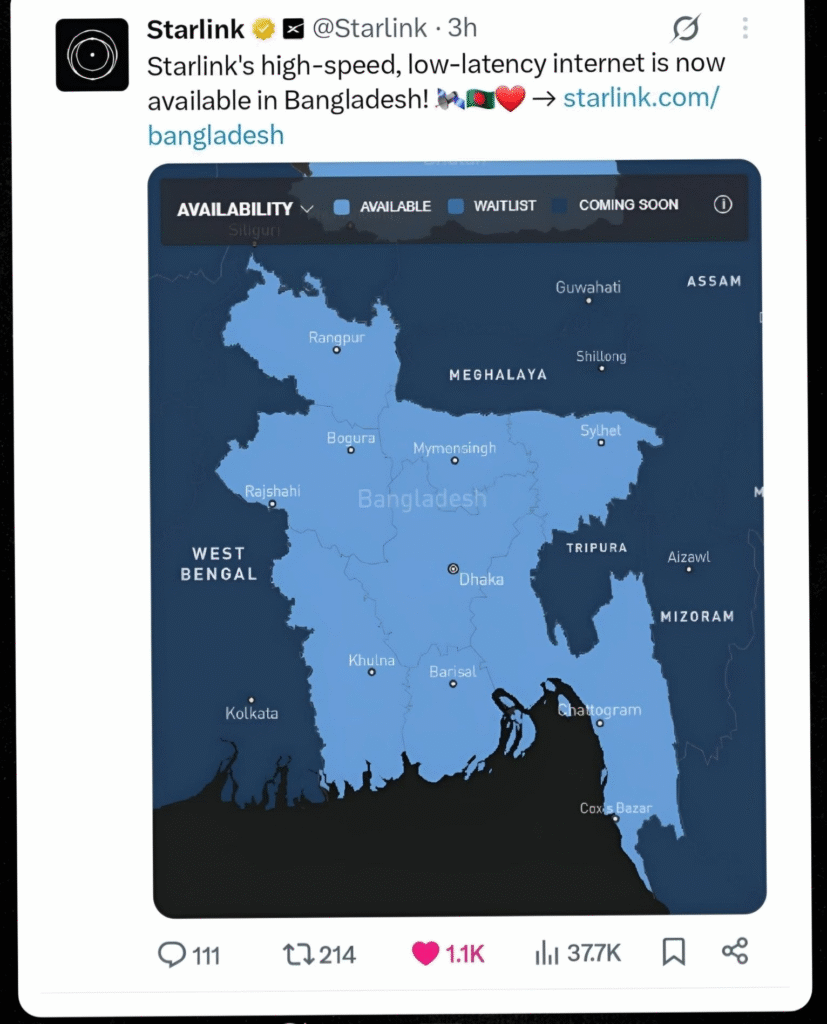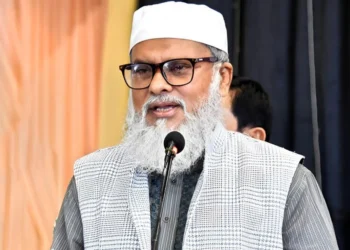1. Introduction: A Gateway to the Future
Imagine a world where everyone can use the internet—whether they live on top of a mountain, deep in a forest, or in the middle of the ocean. This is starting to happen because of Starlink, a satellite internet project by SpaceX, the space company started by Elon Musk.
In the past, the internet mostly came through cables or cell towers. This worked fine in cities and towns. But in faraway villages or remote areas, getting internet has always been very hard. Building towers or putting down cables in those places costs a lot of money and can be very difficult.
This issue is resolved by Starlink. Satellites are used to transmit the internet from orbit. Therefore, even in the most remote regions of the world, individuals may use the internet.
Starlink had millions of customers in more than 130 countries and more than 7,000 satellites in orbit as of September 2024. Bangladesh is one of the countries using this technology officially.
i. Understanding Starlink: Internet from the Stars
Starlink is a satellite internet service developed by a company called SpaceX, founded by Elon Musk. Unlike traditional internet that uses cables and fibre optics, Starlink uses a network of low-orbit satellites to provide internet from space. As they orbit the planet, these satellites transmit signals to tiny dishes positioned at residences or places of business. Because of this, users can access the internet even in locations without traditional broadband.
ii. A New Age of Internet
The main goal of Starlink is to bring high-speed internet to every corner of the world, especially in remote and rural areas. Traditional internet providers often do not serve these areas because building cables is expensive and difficult. But Starlink’s satellite system makes it easier to reach those places without needing cables or towers.
This technology aims to provide individuals with access to knowledge, education, employment, and communication, not just quicker internet. In many places without reliable internet, Starlink has the potential to transform lives.
iii. A Big Step Toward a Digital Future
Introducing Starlink in Bangladesh would not only improve internet access but also open new doors for the country. More people could work online, start digital businesses, and connect with the world. It could help reduce the gap between rich and poor areas in terms of access to technology and information.
In short, Starlink has the potential to change how people live, learn, and work in Bangladesh. It’s a gateway to the future—one that can bring new hope and new opportunities for millions of people.
iv. Starlink in Bangladesh: A New Beginning?
Bangladesh has made great progress in technology, but there are still many areas where good internet access is a challenge. Think about people living far away from cities or in places where it’s expensive and difficult to lay down internet cables. For these people, Starlink could be a game-changer.
v. Reshaping the Digital Landscape
The introduction of Starlink could significantly alter Bangladesh’s digital landscape. It could lead to:
- Increased Internet Penetration: By reaching previously unconnected areas, Starlink can help bridge the digital divide and bring more people online.
- Improved Internet Speed and Reliability: The low latency and high bandwidth offered by Starlink can provide a superior internet experience compared to existing options in many regions.
- Enhanced Access to Online Services: Faster and more reliable internet can facilitate better access to online education, telemedicine, e-commerce, and other essential digital services.
vi. Potential Economic Impact
Beyond the digital sphere, Starlink’s presence in Bangladesh could also have substantial economic implications:
- Boosting E-commerce and Digital Businesses: Reliable internet access can empower entrepreneurs and small businesses across the country to participate in the digital economy.
- Facilitating Remote Work and Global Collaboration: High-speed internet can enable more individuals to engage in remote work opportunities and collaborate with international partners.
- Improving Efficiency in Various Sectors: From agriculture to healthcare, reliable internet connectivity can enhance efficiency and productivity across different sectors of the economy.
This research will further explore these potential impacts, analyse the challenges and opportunities associated with Starlink’s deployment in Bangladesh, and consider its long-term implications for the nation’s progress.
Read More: Flood Crisis in Bangladesh: Urgent Challenges, Economic Impacts, and Climate Change Threats
2. What is Starlink and Why Does It Matter?
i. Introduction to Starlink
Starlink is a satellite-based internet service created by SpaceX, the aerospace company founded by Elon Musk. It is operated by Starlink Services, LLC and works by using thousands of small satellites that orbit close to Earth, known as Low Earth Orbit (LEO) satellites. These satellites send internet signals to special ground receivers on Earth, allowing users to get fast internet even in remote or rural areas.
ii. How Starlink Works
Starlink works through a network of small satellites that orbit close to the Earth. This group of satellites is called a satellite constellation. These satellites communicate with special devices on the ground called user terminals or Starlink dishes.
Here is how it works in simple steps:
- Satellites in space send internet signals down to Earth.
- A user terminal (dish) receives the signal.
- The terminal connects to a Wi-Fi router, giving internet access to homes or businesses.
Because the satellites are in low Earth orbit (LEO) — around 550 kilometres above the Earth — they can provide faster internet with less delay (low latency) than traditional satellites that are much higher in the sky.
iii. Growth and Reach of Starlink
As of September 2024, Starlink has more than 7,000 active satellites in orbit. It serves over 4 million people in more than 130 countries around the world — and now, Bangladesh is also one of the countries using Starlink services.
SpaceX plans to increase the number of satellites to 12,000, and even up to 34,000 in the future. This would make Starlink the largest satellite network in human history.
iv. Why Starlink is Important
a. Connecting Rural and Remote Areas
Many places around the world, especially in rural or hard-to-reach regions, do not have good internet. Traditional internet lines are expensive and difficult to install in such areas. Starlink helps solve this problem by beaming internet directly from space, with no need for cables or towers.
In a country like Bangladesh, Starlink can help bring internet to remote villages, islands, and coastal regions that often suffer from poor connectivity.
b. Fast and Reliable Internet
Because Starlink satellites are much closer to Earth than traditional satellites, they offer low-latency internet. This means faster loading of websites, better video calls, smoother online games, and more reliable streaming.
This is especially helpful for students, teachers, farmers, doctors, and businesses in places where good internet was once a dream.
c. Help During Disasters and Emergencies
Starlink is useful when natural disasters like cyclones, floods, or earthquakes damage communication lines. It can provide internet quickly during emergencies. Starlink has already helped in countries affected by wars, hurricanes, and wildfires, offering fast support when people needed it most.
c. Support for Military and Government Services
Moreover, governments and military institutions value Starlink. A modified version called Starshield is being developed by SpaceX for governmental applications such as national security and defence.
d. Future Space Communication
Starlink is not only useful for Earth. In the future, similar systems may be used to connect planets. For example, Marslink is an idea to build internet on Mars, helping humans communicate between Earth and Mars when SpaceX starts missions to the red planet.
v. Starlink’s Business Success
As a company, Starlink is expanding quickly as well. It made over $7.7 billion by 2024, compared to about $1.4 billion in 2022. It is projected to rise even more in 2025.
Also, the money SpaceX makes from Starlink helps them pay for their other big projects, like the Starship rocket and their plans to go to Mars and the Moon.
vi. The Technology Behind Starlink
Each Starlink satellite weighs between 260 and 300 kg, making them small. They are there to:
- Use solar panels for power.
- Have antennas to send and receive internet signals.
- Use thrusters to move and avoid other objects in space.
- Work with smart software that helps avoid space junk.
Setting up the Starlink user terminal, or dish, is very easy. It connects quickly to the satellites in the sky. A small router gives Wi-Fi right away. This simple system helps people get fast internet even in faraway or remote places.
3. Current State of Internet Connectivity in Bangladesh
i. Urban vs. Rural: A Digital Divide
In Bangladesh, not everyone has equal access to the internet. People living in cities have much better internet than those in villages. Only 36.5% of people in rural areas use the internet, compared to roughly 71.4% of those in urban areas, according to a recent poll conducted by the Bangladesh Bureau of Statistics (BBS).
This gap is growing because rural areas face problems like:
- Not enough internet infrastructure
- High costs for internet services
- Low digital literacy
- Limited local content online
These problems make it difficult for villagers to get online jobs, healthcare, and education.
ii. Challenges with Traditional Internet Providers
Most internet in Bangladesh comes from mobile data and broadband services. However, these services often don’t reach remote areas. Many telecom towers in the country still rely on low-capacity microwave links instead of high-speed fibre connections.
During power outages, which are common, mobile towers can lose battery backup, causing internet disruptions. This makes it difficult for people, especially in rural areas, to stay connected.
iii. Starlink’s Entry into Bangladesh
To address these challenges, Bangladesh has introduced Starlink, a satellite internet service by Elon Musk’s SpaceX. On May 20, 2025, Starlink officially launched in the country, aiming to provide high-speed internet to even the most remote areas.

The service costs about 4,200 Taka ($35) per month, with a one-time equipment fee of 47,000 Taka. While this may be expensive for some, it offers reliable internet that doesn’t depend on local infrastructure.
iv. Government Support and Implementation
The Bangladeshi government, under interim Chief Adviser Muhammad Yunus, has been proactive in bringing Starlink to the country. After discussions with Elon Musk, the government granted Starlink a 10-year license to operate.
This move aims to ensure uninterrupted internet access, especially in disaster-prone and remote regions. Starlink’s satellite-based service is less likely to be affected by power outages or infrastructure issues, making it a valuable addition to Bangladesh’s digital landscape.
Read More: Innovation Design and Entrepreneurship Academy (iDEA): How it Supports Startups Growth in Bangladesh
4. A New Dawn for Digital Equality
Starlink’s entry into Bangladesh heralds a transformative era for digital inclusion, particularly in remote, rural, and disaster-prone regions. By leveraging satellite technology, Starlink aims to bridge the digital divide, offering high-speed internet access where traditional infrastructure falls short.
i. Empowering Remote and Rural Communities
In Bangladesh, many rural areas lack reliable internet connectivity due to challenging terrains and the high costs associated with laying fibre-optic cables. Starlink’s satellite-based service can bypass these obstacles, delivering high-speed internet directly to underserved regions. This advancement opens doors for online education, telemedicine, and e-commerce, fostering economic growth and improving quality of life in these communities.
ii. Enhancing Disaster Resilience
Bangladesh is frequently affected by natural disasters like cyclones and floods, which often disrupt traditional communication networks. Starlink’s satellite internet offers a resilient alternative, maintaining connectivity even when ground-based infrastructure is compromised. This reliability is crucial for coordinating emergency responses and ensuring that affected populations remain connected during crises.
iii. Boosting the Digital Economy
Reliable high-speed internet is a cornerstone of a thriving digital economy. With Starlink, entrepreneurs, freelancers, and small businesses in Bangladesh can access global markets, participate in remote work, and leverage digital tools to enhance productivity. This connectivity can drive innovation and economic diversification, positioning Bangladesh as a competitive player in the global digital landscape.
iv. Promoting Educational Equity
Access to quality education remains uneven across Bangladesh, with rural students often lacking the resources available to their urban counterparts. Starlink’s internet service can democratize education by providing students in remote areas with access to online learning platforms, virtual classrooms, and educational resources, thereby narrowing the educational gap.
5. Bridging the Digital Divide: Starlink’s Role in Connecting Every Corner of Bangladesh
i. Reaching the Unreachable
In Bangladesh, many remote villages, hilly terrains, and island communities still lack reliable internet access. Traditional broadband providers often avoid these areas due to high infrastructure costs. Starlink’s satellite-based internet service can overcome these barriers, delivering high-speed connectivity directly from space to even the most isolated regions.
This advancement can empower rural students, farmers, and entrepreneurs by providing access to online education, markets, and services.
ii. Ensuring Connectivity During Disasters
Bangladesh frequently faces natural disasters like cyclones and floods, which often disrupt communication networks. Starlink’s satellite internet is more resilient to such disruptions, as it doesn’t rely on ground-based infrastructure. This means that during emergencies, affected communities can maintain communication, aiding in timely disaster response and coordination.
iii. Promoting Economic Growth
By providing reliable internet access to underserved areas, Starlink can stimulate local economies. Small businesses can reach broader markets, farmers can access real-time information, and job seekers can explore online opportunities. This connectivity can lead to increased productivity and economic development in rural regions.
iv. Supporting Government Services
Reliable internet is crucial for effective governance. Starlink can facilitate the delivery of government services to remote areas, ensuring that all citizens have access to essential information and services. This includes online applications, public announcements, and access to government programs.
6. Boosting Economic Growth and Innovation
i. Supporting SMEs and Startups
With better internet access, small and medium-sized enterprises (SMEs) in Bangladesh can connect to wider markets, both local and global. Starlink’s high-speed satellite internet can especially help businesses in remote areas, where traditional broadband is either too slow or unavailable. This means entrepreneurs and startups outside Dhaka or major cities can also thrive.
ii. Empowering E-Commerce and Freelancers
E-commerce has been growing rapidly in Bangladesh. Platforms like Daraz, Evaly (formerly), and local Facebook-based shops depend heavily on internet connectivity. With Starlink, even rural sellers can easily access online platforms, manage logistics, and interact with customers.
Additionally, freelancers—especially from districts like Jashore, Khulna, or Rajshahi—will have better opportunities to work on global platforms like Upwork or Fiverr without connection issues.
iii. Strengthening the Digital Economy
A stable and fast internet is key for digital transformation. From digital banking to online services, improved connectivity helps build a smarter economy. Starlink’s technology could make it easier to adopt digital tools, cloud services, and AI-based systems even in semi-urban or rural businesses.
iii. Encouraging Innovation Across Sectors
Fintech, health companies, and agriculture tech all benefit from dependable internet access. Starlink can encourage young people to become innovators rather than merely job searchers and assist in creating tech hubs outside of large cities.
7. Challenges and Regulatory Considerations
i. High Costs: A Major Barrier
Starlink’s pricing poses a significant challenge for widespread adoption in Bangladesh. The service costs about 4,200 Taka ($35) per month, with a one-time equipment fee of 47,000 Taka. While this may be expensive for some, it offers reliable internet that doesn’t depend on local infrastructure. Mobile internet packages cost between ৳400-500 for 30GB. Given the price-sensitive nature of the Bangladeshi market, affordability remains a major concern.

ii. Regulatory and Licensing Hurdles
The Bangladesh Telecommunication Regulatory Commission (BTRC) has requested SpaceX to apply for an operating license, but regulatory challenges may delay the approval process. The government’s ‘lawful interception requirement’—which allows authorities to monitor telecommunication networks—could also pose a potential roadblock.
iii. Weather-Related Service Disruptions
While Starlink has shown resilience to some adverse conditions, heavy rainfall and storms—common during Bangladesh’s monsoon season—could still disrupt service. This raises concerns about the reliability of Starlink during extreme weather events.
iv. Competition from Existing ISPs
Bangladesh already boasts a well-established network of 13.18 crore internet users, including 1.25 crore broadband and 11.94 crore mobile internet connections. Local ISPs and mobile operators could respond to Starlink’s entry with competitive pricing, improved services, and better customer retention strategies, making it harder for Starlink to penetrate the market.
8.Global Lessons and Local Adaptations
Countries worldwide have adopted Starlink to enhance internet connectivity, especially in remote and underserved regions. Bangladesh can draw valuable insights from these global experiences to effectively integrate Starlink into its digital infrastructure.
i. Learning from India’s Strategic Approach
India is preparing to launch Starlink with monthly plans starting at approximately ₹850 (around $10), aiming to provide affordable high-speed internet to rural areas. The Indian government is facilitating this rollout by offering regulatory support and encouraging partnerships between Starlink and local telecom providers like Jio, Airtel, and Vodafone. This collaborative model ensures broader reach and smoother integration into the existing telecom ecosystem.
ii. Africa’s Experience: Balancing Access and Affordability
In several African countries, including Nigeria and Kenya, Starlink has rapidly gained popularity due to its ability to deliver reliable internet in areas lacking traditional infrastructure. However, challenges have arisen regarding pricing and regulatory compliance. For instance, sudden price hikes in Nigeria led to public outcry and regulatory intervention, highlighting the need for clear pricing strategies and adherence to local regulations.
english.elpais.com
iii. Ukraine’s Emergency Deployment: Ensuring Resilience
During the Russian invasion, Ukraine utilized Starlink to maintain internet connectivity when traditional networks were compromised. This emergency deployment underscores Starlink’s potential to provide resilient communication channels during crises, a lesson pertinent to Bangladesh given its vulnerability to natural disasters.
iv. Key Takeaways for Bangladesh
- Affordability Measures: Implementing subsidized pricing or community-sharing models can make Starlink more accessible to low-income populations.
- Regulatory Framework: The seamless integration and operation of satellite internet services will be made possible by the establishment of precise regulations and compliance standards.
- Local Partnerships: Collaborating with existing telecom providers can enhance distribution and customer support, leveraging established networks and expertise.
- Emergency Preparedness: By integrating Starlink into plans for disaster response, communication can continue unhindered in an emergency.
By analysing global implementations of Starlink, Bangladesh can adopt best practices and tailor strategies to its unique context, promoting inclusive and resilient digital connectivity across the nation.
9. The Road Ahead: Building a Connected Bangladesh
Bangladesh is rapidly moving towards a future connected by digital means! Imagine having more services at your fingertips and faster internet.
- Boosting Digital Power: The government is actively pushing for nationwide digital transformation. It is anticipated that more government services will be made available online, which would simplify life for all. ‘National Digital Transformation Strategy’ and other ambitious goals are aimed at delivering even more services to your computer or phone.
- Connecting Everyone: The objective is to connect every region of Bangladesh, even as more people get online. Cities and towns will gain from the digital world as more people get access to the internet.
- Hello 5G! Get ready for super-fast internet speeds with the upcoming 5G technology. This will revolutionize everything from how we work and learn to how businesses operate, bringing exciting new possibilities.
- Tech is the Key: Bangladesh is embracing new technologies like AI and blockchain. These advancements will help create innovative solutions and open up new opportunities for growth and development in the country.
10. The Future is Bright: Powered by Connection
Imagine a Bangladesh where no matter how remote, every corner is connected to the world. This dream could become reality with innovations like Starlink. Bangladesh stands at a pivotal moment in its digital journey. The introduction of Starlink’s satellite internet service offers a transformative opportunity to bridge the digital divide, especially in remote and underserved regions.
With high-speed, reliable connectivity, communities previously left behind can access online education, telemedicine, and global markets, fostering inclusive economic growth. This advancement aligns with the nation’s broader goals of digital inclusion and economic dynamism, positioning Bangladesh as a forward-thinking player in the global digital economy.
- Closing the Digital Gap: Starlink has the potential to connect those areas of Bangladesh that traditional internet struggles to reach. This means people in rural and hard-to-access regions could finally have reliable, high-speed internet.
- Boosting the Economy: Better internet for everyone can fuel economic growth. Small businesses in villages could reach global markets, and new opportunities in e-commerce and online services could emerge everywhere.
- Empowering People: With better access to information and online services, people across Bangladesh can benefit from improved education, healthcare, and more. This digital inclusion will empower communities and create a more dynamic nation.
Looking forward, embracing technologies like Starlink can help Bangladesh leapfrog traditional infrastructure challenges and build a truly connected, digitally empowered, and economically vibrant future for all its citizens.
Conclusion: Lighting Up Bangladesh’s Digital Horizon
Bangladesh is stepping into a bold new digital era—and Starlink could be the spark that lights the way. With its powerful satellite internet, Starlink offers the chance to connect even the most remote corners of the country. From hill tracts to coastal villages, students, farmers, doctors, and entrepreneurs could soon enjoy reliable internet access that was once a dream.
However, there will be difficulties along the way. Strong collaborations and clever solutions are required for local infrastructure, affordability, and regulation. To guarantee that no one is left behind, the public and private sectors must cooperate.
If embraced wisely, Starlink can do more than provide internet—it can power education, boost rural healthcare, create jobs, and fuel digital growth. Bangladesh has the potential to lead as a truly connected nation in South Asia—smart, inclusive, and ready for the future.
References:
Share via:


















